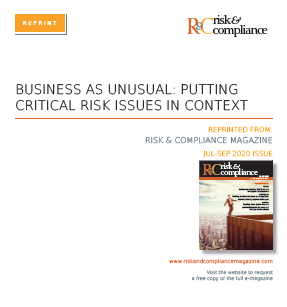Business as Unusual: Putting Critical Risk Issues in Context
We discuss changes in and reactions to business continuity and supply chain activity with Risk & Compliance magazine.
- James Green was SAI360’s Director of Risk Advisory Services
- July/September 2020 issue

|
R&C: Recent disruptions have substantially impacted small enterprises through to global corporations. To what extent do these events demonstrate how fragile global infrastructures and supply chains can be?
Green: We began talking about COVID-19 in late January 2020 as a supply chain issue first and foremost. While it eventually became a pandemic and business continuity issue, initially it was a supply chain issue. What we are really seeing for the fragility of infrastructure is – and companies are finding this out in a very hard way – you can outsource the process, but you cannot outsource the risk.
What that means in a supply-chain context is if you rely on a vendor for a good or service to finalize the good or service that you provide to a customer, and something upstream falls down, you have to go to your customer and tell them that you cannot deliver what you promised. The customer is not going to care why. They are not going to care if it was one level up in your supply chain or two or three or four. What they know is that you failed them.
Companies need to be mindful as they more tightly integrate supply chains and as they move to more diverse pools of vendors, they must stay on top of what the impact of those vendors will be on their business if they have a disruption.
“Now is the time to create plans that are actionable and turn those plans into programs that will sustain and grow when a few months down the road management has moved on to something else.”
James Green
More questions addressed in the interview:
- Steps that companies have taken to operationalize their rapid response to the coronavirus health crisis and the resulting economic downturn
- Insights into how companies should be preparing for a return to work
- The level of available resources and executive buy-in that business continuity and risk management professionals are working with
- How important it is for companies to focus on effective crisis management, with real-time tracking and reports
- Considerations that companies need to make when communicating with important stakeholders, both internal and external, including how they’re addressing problems with clear planning
- Advice for companies on protecting their most important assets: people, information, cash flow and reputation
- How the COVID-19 pandemic is forcing companies to accept change and think about their future, including the adoption of digital transformation and innovation
Learn about our business continuity management solutions.



